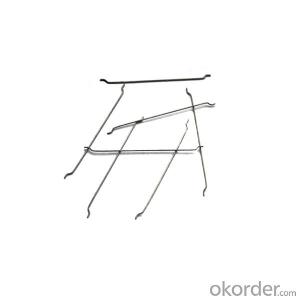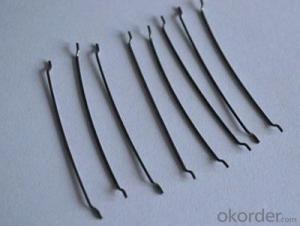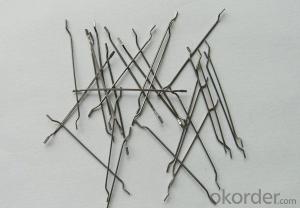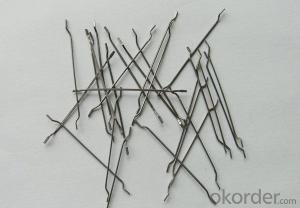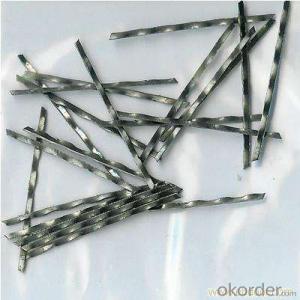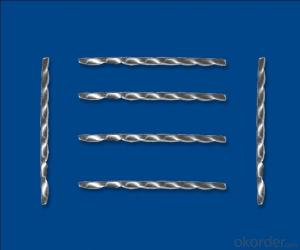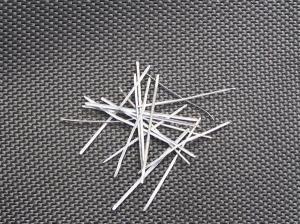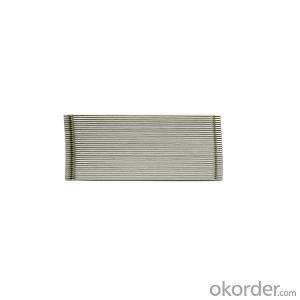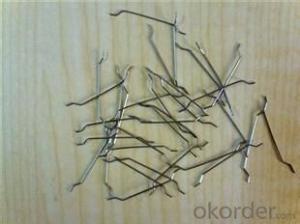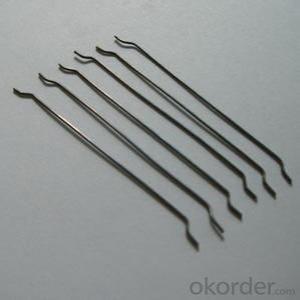For concrete reinforcement high quality steel fiber
- Loading Port:
- Tianjin
- Payment Terms:
- TT OR LC
- Min Order Qty:
- 1 m.t.
- Supply Capability:
- 600 m.t./month
OKorder Service Pledge
Quality Product, Order Online Tracking, Timely Delivery
OKorder Financial Service
Credit Rating, Credit Services, Credit Purchasing
You Might Also Like
Quick Details
Place of Origin: Tianjin, China (Mainland)
- Model Number: 0.75
Material: Steel
Production Process: Cold drawn
Fiber Lengh: 60
Type: 1
Compressive Strength: >1200MPa
Aspect ratio: 80
Standard: ASTM A820M-11
Section Shape: Circular
Application: Concrete Reinforcement
- Product application: Floor
Packaging & Delivery
| Packaging Details: | 20 kg/Bag,50 bags/Pallet or 1,000kg/ Bulk Bag |
|---|---|
| Delivery Detail: | 1 Month |
Product Description
| Diameter | 0.75 | mm | 0.03 | in |
| Length | 60.00 | mm | 2.35 | in |
| Aspect Ratio | 80 | |||
| Tensile strength | 1200 MPa | |||
| Type | Cold drawn Steel Fiber | |||
| End | Hooked-end Steel Fiber | |||
| Glued/Loose | Glued Steel Fiber | |||
| Bending Angle | 45°(min.30°) | |||
| Usage & Performance | Floor:Trafficked areas and Industrial floors | |||
| Shotcrete :Slope stabilization and Final lining | ||||
| Precast concrete:Pipe and Railway sleepers | ||||
| Packing | Standard Export Pallet Packing | Bag Packing | 20 kg/Bag,50 bags/Pallet | |
| Bulk Packing | 1,000kg/ Bulk Bag | |||
| Loading Quantity | 20’GP | 20-25 Tonne/Tonnes | ||
| 40’GP | 25-27 Tonne/Tonnes | |||
| 40’HQ | 25-27 Tonne/Tonnes | |||
| MOQ | 1 kg for trial order | |||
| Supply Ability | 10,000 Tonne/Tonnes per Year | |||
| Payment Terms | T/T or L/C at sight | |||
| Delivery Time | Within 15 days after receiving deposit or original L/C at sight | |||
| Certification | ISO9001:2000, CE, | |||

| Product | Diameter | Length mm/in | Aspect Ratio | Type | Packing |
| G-6030 | 0.5 mm (0.0197 in) | 30 mm (1.1811 in) | 60 | Glued | 20 kg/Bag, or 1,000kg/ Bulk Bag |
| G-6535 | 0.55 mm (0.0217 in) | 35 mm (1.3780 in) | 65 | Glued | 20 kg/Bag, or 1,000kg/ Bulk Bag |
| G-6035 | 0.6 mm (0.0236 in) | 35 mm (1.3780 in) | 60 | Glued | 20 kg/Bag, or 1,000kg/ Bulk Bag |
| G-8060 | 0.75 mm (0.0295 in) | 60 mm (2.3622 in) | 80 | Glued | 20 kg/Bag, 50 bags/Pallet |
| G-6060 | 0.9 mm (0.0354 in) | 60 mm (2.3622 in) | 60 | Glued | 20 kg/Bag, 50 bags/Pallet |
| G-6030 | 0.5 mm (0.0197 in) | 30 mm (1.1811 in) | 60 | Loose | 20 kg/Bag, or 1,000kg/ Bulk Bag |
| G-6535 | 0.55 mm (0.0217 in) | 35 mm (1.3780 in) | 65 | Loose | 20 kg/Bag, or 1,000kg/ Bulk Bag |
| G-6035 | 0.6 mm (0.0236 in) | 35 mm (1.3780 in) | 60 | Loose | 20 kg/Bag, or 1,000kg/ Bulk Bag |
| G-8060 | 0.75 mm (0.0295 in) | 60 mm (2.3622 in) | 80 | Loose | 20 kg/Bag, 50 bags/Pallet |
| G-6060 | 0.9 mm (0.0354 in) | 60 mm (2.3622 in) | 60 | Loose | 20 kg/Bag, 50 bags/Pallet |
- Q:Is melt extract stainless steel fiber compatible with different types of aggregates?
- Yes, melt extract stainless steel fiber is compatible with different types of aggregates. Stainless steel fiber is commonly used as a reinforcing material in concrete to enhance its tensile strength, durability, and resistance to cracking. It can be mixed with various types of aggregates, such as sand, gravel, crushed stone, or recycled materials, without affecting its compatibility. The fibers are evenly distributed throughout the concrete mixture, improving its overall performance and preventing the formation of cracks. Moreover, the stainless steel fibers do not react chemically with the aggregates, ensuring their compatibility and long-term stability.
- Q:Can melt extract stainless steel fiber be used in precast concrete panels?
- Melt extract stainless steel fiber is a suitable option for incorporating into precast concrete panels. It is extensively utilized in the construction sector to augment the mechanical characteristics of concrete. By enhancing tensile strength, ductility, and crack resistance, these fibers effectively enhance the durability and prevent cracking. When utilized in precast concrete panels, where the concrete is poured into molds and cured prior to being transported to the construction site, melt extract stainless steel fibers offer supplementary reinforcement that prevents crack formation during transportation and installation. This ensures the long-term structural integrity and performance of the precast concrete panels.
- Q:How does melt extract stainless steel fiber impact the load transfer between concrete layers?
- The load transfer between concrete layers is greatly affected by melt extract stainless steel fiber. When incorporated into the concrete mix, these fibers serve as reinforcement, thereby increasing the tensile strength of the material. This reinforcement aids in the even distribution of the load across the concrete layers, effectively transferring the applied load from one layer to another. By uniformly dispersing the stainless steel fibers within the concrete matrix, a connected network is formed, which enhances the overall structural integrity. Consequently, crack propagation is prevented and existing cracks between concrete layers are restricted in their development and widening. This behavior is of utmost importance in load-bearing structures as it improves the concrete's capacity to bear loads and its durability. Additionally, the presence of melt extract stainless steel fibers assists in mitigating the negative effects of shrinkage and thermal stresses on concrete. These fibers decrease the likelihood of cracking caused by temperature fluctuations by providing reinforcement and hindering the formation of large cracks. Consequently, the load transfer between layers is enhanced as the structural integrity of the concrete is maintained. In conclusion, the inclusion of melt extract stainless steel fibers in concrete significantly enhances the load transfer between layers. These fibers reinforce the concrete matrix, distribute the applied load more evenly, prevent crack propagation, and mitigate shrinkage and thermal stresses. Ultimately, this results in a stronger and more durable concrete structure with an improved capacity to bear loads and an extended lifespan.
- Q:How does the presence of melt extract stainless steel fiber affect the creep behavior of concrete?
- Concrete's creep behavior is significantly affected by the presence of melt extract stainless steel fiber. Creep refers to the gradual deformation of concrete over time when subjected to a sustained load. As a reinforcement material, melt extract stainless steel fibers enhance the tensile strength and overall performance of concrete. These fibers are typically added to the concrete mixture during the mixing process. Their addition creates a three-dimensional network within the concrete matrix, promoting a more even distribution of the applied load. One of the main benefits of melt extract stainless steel fibers is the reduction of creep in concrete. Acting as internal reinforcements, these fibers effectively restrict the movement and deformation of the concrete under load over time. Consequently, the presence of these fibers improves the long-term stability and durability of concrete structures by minimizing creep-induced deformations. Furthermore, melt extract stainless steel fibers also improve the cracking resistance of concrete. By reinforcing the concrete matrix, these fibers help control the propagation of cracks, preventing their enlargement and reducing the potential for further damage. This is particularly crucial in structures exposed to high loads or thermal variations, as it maintains the integrity of the concrete over time. In addition to reducing creep and enhancing cracking resistance, melt extract stainless steel fibers also enhance the overall mechanical properties of concrete. They increase its flexural strength, impact resistance, and fatigue resistance, making it more resilient to various types of loads and stresses. To summarize, the presence of melt extract stainless steel fibers in concrete positively impacts its creep behavior. It reduces deformation under sustained load, improves cracking resistance, and enhances the overall mechanical properties of concrete. Consequently, this leads to a more durable and long-lasting construction material.
- Q:Can melt extract stainless steel fiber be used in high-density concrete?
- Yes, melt extract stainless steel fibers can be used in high-density concrete. These fibers are known for their high strength and corrosion resistance, making them suitable for reinforcing concrete in demanding applications. The addition of these fibers can enhance the overall performance and durability of high-density concrete.
- Q:Can melt extract stainless steel fiber be used in precast bridge column elements?
- Yes, melt extract stainless steel fiber can be used in precast bridge column elements. It is commonly used to enhance the mechanical properties and durability of concrete, making it suitable for high-performance applications such as bridge construction. The addition of stainless steel fibers improves the flexural strength, crack resistance, and overall structural integrity of the precast elements, making them more robust and able to withstand the demands of bridge column construction.
- Q:How does melt extract stainless steel fiber prevent cracking in concrete?
- Melt extract stainless steel fiber is a specialized reinforcement material designed to prevent cracking in concrete. By creating a three-dimensional network within the concrete matrix, these fibers enhance its tensile strength and resistance to cracks. One way in which melt extract stainless steel fiber prevents cracking is by evenly distributing stress throughout the concrete structure. As the concrete shrinks or expands due to temperature changes, these fibers act as small reinforcement bars, limiting the formation and spread of cracks. By effectively dispersing stress, the fibers help preserve the concrete's structural integrity and prevent the formation of large cracks. Furthermore, the high tensile strength of stainless steel fibers plays a role in crack prevention. These fibers can withstand significant forces without breaking, thereby resisting crack development in the concrete. This is particularly advantageous in high-stress areas like industrial floors, pavements, and overlays, where cracking is a common problem. Moreover, the presence of stainless steel fibers in the concrete enhances its overall durability and lifespan. These fibers improve resistance to abrasion, impact, and fatigue, making the concrete more resilient against external forces and reducing the likelihood of crack formation. In conclusion, melt extract stainless steel fiber is a reliable reinforcement material that effectively prevents cracking in concrete. Its ability to distribute stress, withstand tensile forces, and enhance durability makes it an excellent choice for maintaining the structural integrity of concrete and prolonging its lifespan.
- Q:What is the effect of melt extract stainless steel fiber on the thermal conductivity of concrete?
- The inclusion of melt extract stainless steel fiber in concrete can significantly improve the thermal conductivity of the material. Stainless steel fibers have excellent thermal conductivity properties, meaning they can efficiently transfer heat throughout the concrete. When these fibers are added to the concrete mix, they form a three-dimensional network that helps to conduct and distribute heat more effectively. This enhanced thermal conductivity can have several positive effects on the concrete's performance. Firstly, the increased thermal conductivity can improve the overall thermal efficiency of structures built with this type of concrete. It allows for better heat transfer, which can help regulate temperatures more efficiently, reducing the need for additional insulation or heating and cooling systems. Additionally, the improved thermal conductivity can also enhance the durability of the concrete. By evenly distributing heat and minimizing temperature gradients, the risk of thermal cracking and damage due to thermal expansion and contraction is reduced. This is especially beneficial in environments with significant temperature variations. Moreover, the higher thermal conductivity provided by melt extract stainless steel fiber can also be advantageous in applications such as radiant floor heating systems. The fibers can efficiently transfer heat from the heating elements to the surface, resulting in more efficient and effective heating. In summary, the inclusion of melt extract stainless steel fiber in concrete significantly enhances its thermal conductivity. This improvement can lead to increased thermal efficiency, improved durability, and better performance in various applications where heat transfer is a critical factor.
- Q:Can melt extract stainless steel fiber be used in tunnel segment construction?
- Yes, melt extract stainless steel fiber can be used in tunnel segment construction. Stainless steel fibers are known for their high tensile strength, corrosion resistance, and durability. These properties make them suitable for reinforcing concrete in tunnel segments, which need to withstand the high loads and harsh environments typically found in tunnel construction. The addition of stainless steel fibers to the concrete mix can improve its flexural strength, reduce cracking, and enhance its overall structural integrity. Furthermore, the melt extract manufacturing process ensures that the fibers have a uniform distribution and are properly bonded to the concrete matrix, further enhancing their effectiveness in tunnel segment construction.
- Q:Can melt extract stainless steel fiber be used in structural repair applications?
- Certainly! Melt extract stainless steel fiber is a viable option for structural repair tasks. This particular fiber is obtained by melting stainless steel and quickly extracting it into filaments, creating a robust and long-lasting material. Because of its exceptional strength and resistance to corrosion, melt extract stainless steel fiber is frequently utilized in the repair and reinforcement of concrete structures. It can be incorporated into the concrete mixture to bolster its structural integrity, improve its durability, and prevent the occurrence of cracks. Additionally, this fiber can be employed to mend damaged structures by introducing it into the repair mortar or concrete, which enhances the strength of the repaired section. Overall, melt extract stainless steel fiber is a suitable choice for structural repair endeavors, thanks to its remarkable mechanical properties and ability to enhance the performance and lifespan of repaired structures.
1. Manufacturer Overview |
|
|---|---|
| Location | |
| Year Established | |
| Annual Output Value | |
| Main Markets | |
| Company Certifications | |
2. Manufacturer Certificates |
|
|---|---|
| a) Certification Name | |
| Range | |
| Reference | |
| Validity Period | |
3. Manufacturer Capability |
|
|---|---|
| a)Trade Capacity | |
| Nearest Port | |
| Export Percentage | |
| No.of Employees in Trade Department | |
| Language Spoken: | |
| b)Factory Information | |
| Factory Size: | |
| No. of Production Lines | |
| Contract Manufacturing | |
| Product Price Range | |
Send your message to us
For concrete reinforcement high quality steel fiber
- Loading Port:
- Tianjin
- Payment Terms:
- TT OR LC
- Min Order Qty:
- 1 m.t.
- Supply Capability:
- 600 m.t./month
OKorder Service Pledge
Quality Product, Order Online Tracking, Timely Delivery
OKorder Financial Service
Credit Rating, Credit Services, Credit Purchasing
Similar products
New products
Hot products
Hot Searches
Related keywords
